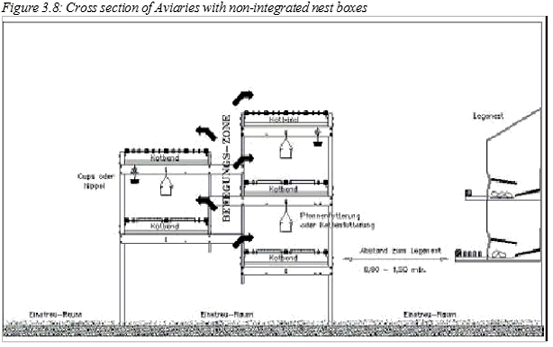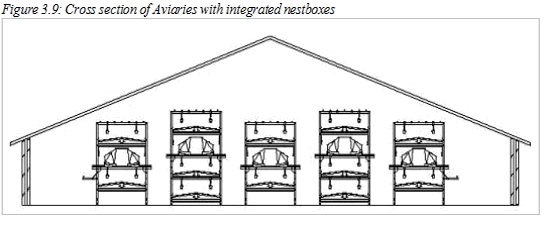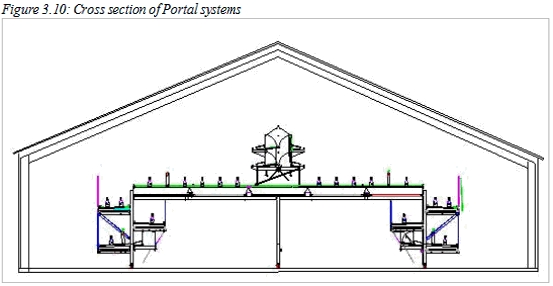Multi-tiered non-cage systems
Aviaries with non-integrated nest boxes
The earlier type of aviaries have stacks of elevated floors and separate units of nestboxes. Between the elevated floors and the nestboxes an aisle covered with litter is positioned to enable carers to walk through the system and to provide litter to the hens. The elevated floors often have a slight slope to allow eggs to roll towards the side of the floors. Often there is a perch positioned along the side of the perforated floors with enough space underneath to cover mislaid eggs and thus protect them from claws or pecks of birds. Under each elevated floor a manure belt is positioned to prevent manure from falling on the lower levels and to transport manure out of the henhouse. The nestboxes (individual or group nests) can be lined in one row or in more rows above eachother.
Between the elevated floors there is a space of at least 45 cm heigh as this is the minimum height required by law. On the elevated floors water and feed is provided. Water is usually provided through nipple drinkers, but cups are also possible. Feed can be provided by means of chain feeders or feeding pans.
Perches are located over the elevated floors. The top floor usually has many perches, the lower floors often have only perches along the sides of the floors.
Litter is provided on the bottom of the henhouse. In some systems the entire floor is covered with litter and birds can walk underneath the elevated floors. Other systems have the area underneath the elevated floors blocked, so that hens have to jump onto the slatted floors to continue.
Manufacturers Aviaries with non-integrated nest boxes:
D: Big Dutchman, Farmer Automatic, Fienhage, Salmet, Specht
S: Oli-FreeNL: Jansen PE, Vencomatic
CH: Volito
Aviaries with integrated nestboxes
The later type of aviaries have stacks of elevated floors with units of nestboxes integrated in the same stack. Often stacks with integrated nestboxes are alternated with stacks without nestboxes. Between the different stacks of floors an aisle covered with litter is positioned to enable carers to walk through the system and to provide litter to the hens. The elevated floors often have a slight slope to allow eggs to roll towards the side of the floors. Often there is a perch positioned along the side of the perforated floors with enough space underneath to cover mislaid eggs and thus protect them from claws or pecks of birds. Under each elevated floor a manure belt is positioned to prevent manure from falling on the lower levels and to transport manure out of the henhouse. The nestboxes (individual or group nests) usually are lined in 2 rows connected with the back of the nests.
Between the elevated floors there is a space of at least 45 cm heigh as this is the minimum height required by law. On the elevated floors water and feed is provided. Water is usually provided through nipple drinkers, but cups are also possible. Feed can be provided by means of chain feeders or feeding pans.
Perches are located over the elevated floors. The top floor usually has many perches, the lower floors often have only perches along the sides of the floors. Perches are also placed in front of the nestboxes.
Litter is provided on the bottom of the henhouse. In some systems the entire floor is covered with litter and birds can walk underneath the elevated floors. Other systems have the area underneath the elevated floors blocked, so that hens have to jump onto the slatted floors to continue.
Manufacturers Aviaries with integrated nestboxes:
D: Big Dutchman, Farmer Automatic, Fienhage, Salmet
NL: Jansen PE, Vencomatic
Aviaries with integrated nestboxes
The later type of aviaries have stacks of elevated floors with units of nestboxes integrated in the same stack. Often stacks with integrated nestboxes are alternated with stacks without nestboxes. Between the different stacks of floors an aisle covered with litter is positioned to enable carers to walk through the system and to provide litter to the hens. The elevated floors often have a slight slope to allow eggs to roll towards the side of the floors. Often there is a perch positioned along the side of the perforated floors with enough space underneath to cover mislaid eggs and thus protect them from claws or pecks of birds. Under each elevated floor a manure belt is positioned to prevent manure from falling on the lower levels and to transport manure out of the henhouse. The nestboxes (individual or group nests) usually are lined in 2 rows connected with the back of the nests.
Between the elevated floors there is a space of at least 45 cm heigh as this is the minimum height required by law. On the elevated floors water and feed is provided. Water is usually provided through nipple drinkers, but cups are also possible. Feed can be provided by means of chain feeders or feeding pans.
Perches are located over the elevated floors. The top floor usually has many perches, the lower floors often have only perches along the sides of the floors. Perches are also placed in front of the nestboxes.
Litter is provided on the bottom of the henhouse. In some systems the entire floor is covered with litter and birds can walk underneath the elevated floors. Other systems have the area underneath the elevated floors blocked, so that hens have to jump onto the slatted floors to continue.
Manufacturers Aviaries with integrated nestboxes: D: Big Dutchman, Farmer Automatic, Fienhage, Salmet NL: Jansen PE, Vencomatic  Portal systemsThe youngest type of aviaries have stacks of elevated floors with units of nestboxes integrated in the same stack. On top of two of those stacks, connecting the two stacks, a single level system is placed. Between the different stacks of floors, under the single level part, an aisle covered with litter is positioned to enable carers to walk through the system and to provide litter to the hens. On the outside of the two stacks there is also an aisle covered with litter. Litter actually runs underneath all stacks and is covering the complete floor area of the henhouse.
Portal systemsThe youngest type of aviaries have stacks of elevated floors with units of nestboxes integrated in the same stack. On top of two of those stacks, connecting the two stacks, a single level system is placed. Between the different stacks of floors, under the single level part, an aisle covered with litter is positioned to enable carers to walk through the system and to provide litter to the hens. On the outside of the two stacks there is also an aisle covered with litter. Litter actually runs underneath all stacks and is covering the complete floor area of the henhouse.
The elevated floors often have a slight slope to allow eggs to roll towards the side of the floors. Often there is a perch positioned along the side of the perforated floors with enough space underneath to cover mislaid eggs and thus protect them from claws or pecks of birds. Under each perforated floor a manure belt is positioned to prevent manure from falling on the lower levels and to transport manure out of the henhouse. The nestboxes (group nests) are lined in 1 row in each stack of floors and also in 2 rows connected with the back of the nests on top of the system (as part of the single level part).
Between the elevated floors there is a space of at least 45 cm heigh as this is the minimum height required by law. On the elevated floors water and feed is provided. Water is usually provided through nipple drinkers, but cups are also possible. Feed can be provided by means of chain feeders or feeding pans.
Perches are located over the elevated floors.
Litter is provided on the entire floor of the henhouse and birds can walk underneath the elevated floors.
Manufacturers Portal systems:
D: Farmer Automatic, Fienhage, Meller
NL: Jansen PE, Vencomatic
